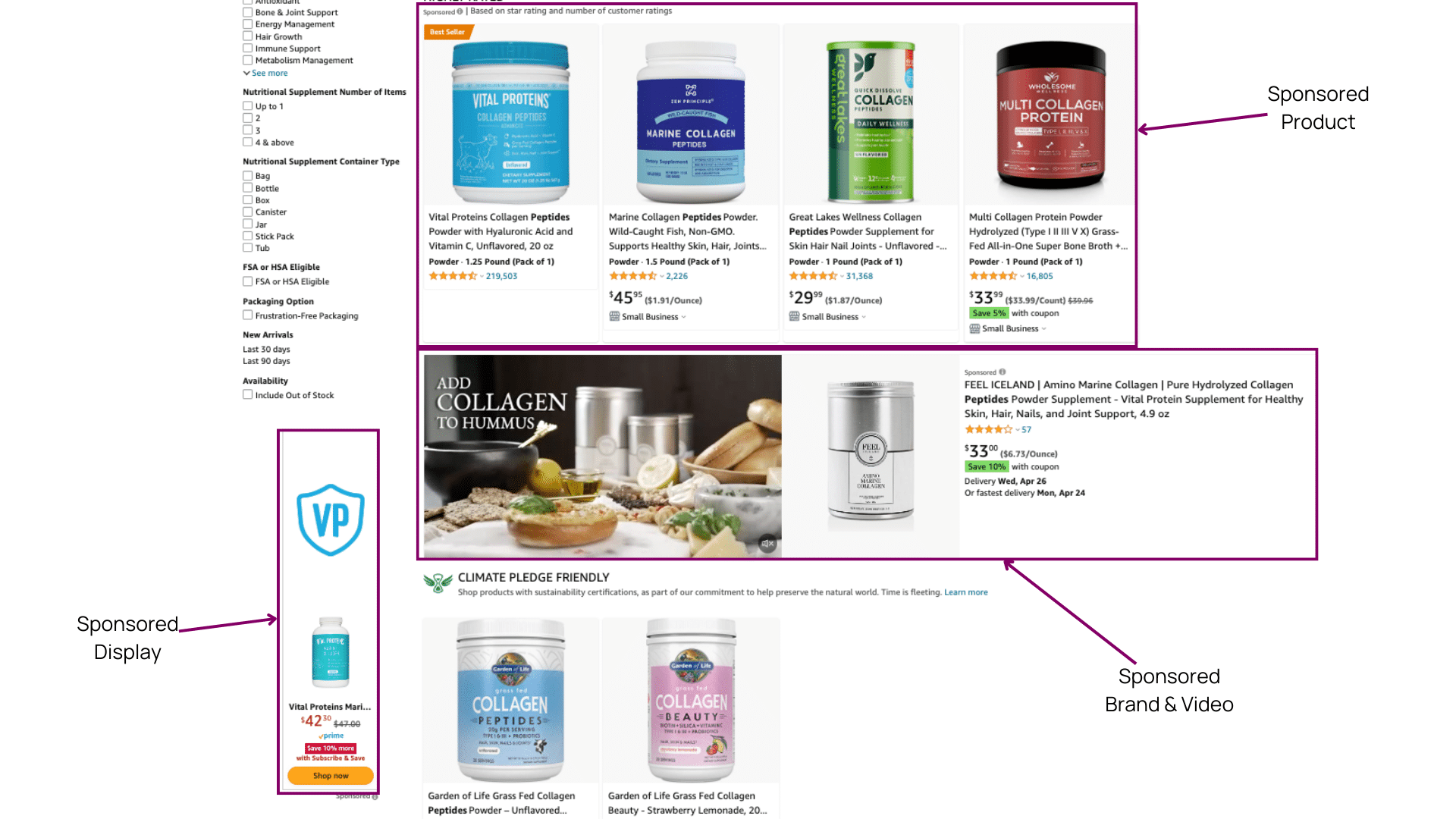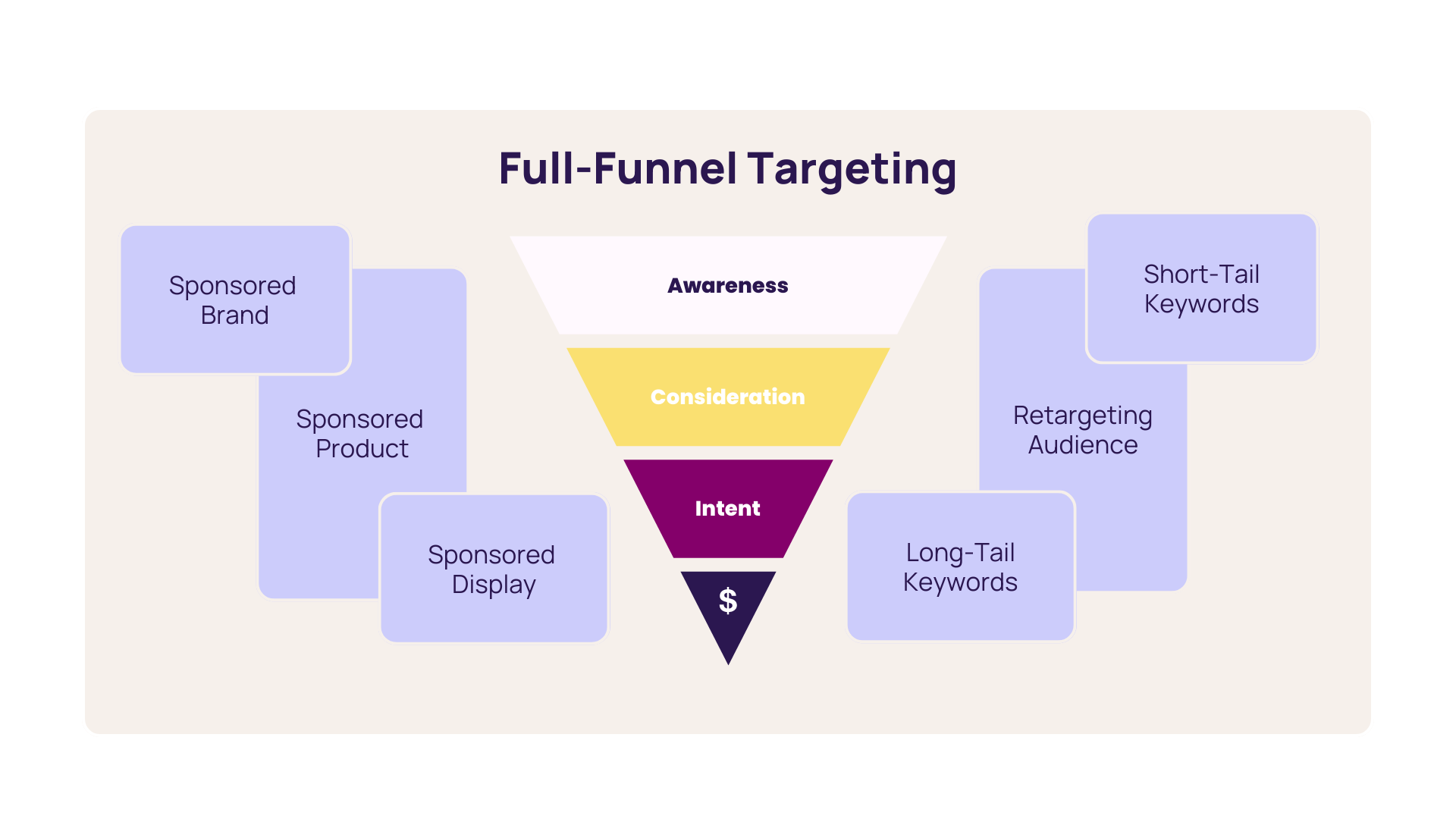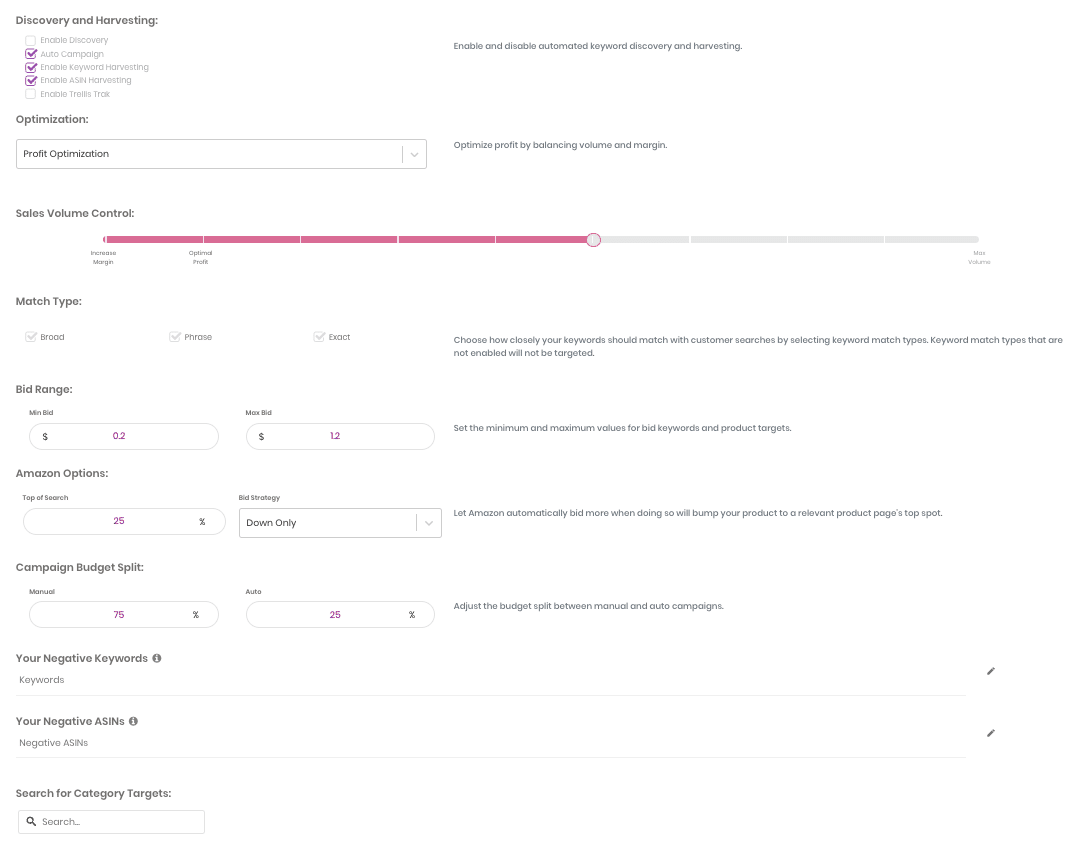Advertisers try to be at the right place, at the right time. To position products effectively, analyzing data is essential. It helps advertisers make better decisions and improve spending efficiency. While data analysis requires time and expertise, automation with AI implements data-driven insights faster, which takes hours to do manually.
Imagine downloading all the campaign reports, aligning them on a single spreadsheet, matching the fields, filtering out irrelevant fields, tagging and segmenting the keywords/ASINs and products, sorting them through various metrics like clicks, impressions, or conversions, and then finding opportunities.
Now imagine a tool that does all of the above with a few clicks over predefined goals and strategies. You can test, learn, and adapt more quickly than using slow-moving advertising workflows.
Given Amazon PPC is one of the biggest challenges for Amazon sellers and most of the merchandising budget is spent on advertising, Amazon sellers must get Ad Placement right to grow their eCommerce business.
Using the right platform and streamlined workflows can help brands hit sales targets with desirable profit margins. This blog covers how to automate advertising in highly competitive marketplaces like Amazon using proven workflows
Streamlined ad Placement process
Ad campaigns consist of everything from research to optimization. Starting with your products’ goal as a north star, your strategy and workflows should ensure that each action you take contributes to its success.

To help get you there, here is a proven Ad Placement workflow:
1. Collect the data and segment it
Data collection is the first step in creating an Amazon PPC strategy. On Amazon you can do it by analyzing various Seller Central reports. While the results from those siloed reports can give you direction, analyzing them collectively can help you find even better opportunities.
Once you have collected all of your data in one place, segment your inventory based on your products’ objectives. Most commonly you can sort data by growth, or profitability.
Following your objectives, you can find opportunities, identify risks and optimize to create an efficient optimization cycle.
For example, your toothbrush brand isn’t growing and you want to increase market share. For that, you can analyze the data from all reports together and look for:
- Search term reports: List of high-performing keywords for toothbrushes,
- Product performance reports: Identifying products with repeated sales,
- Campaign reports: High engagement Ad Placements; Sponsored Product and Sponsored Brand Videos, and
- Brand Analytics: Declining Share of Voice in the toothbrush category
By getting insights from all the reports, you can increase market share by advertising the best-selling toothbrushes that have repeated sales on the most converting ad placements bidding on high-performing keywords.
2. Implement the best variables for your objective
Once you’ve collected the data, you can start implementing the most effective advertising strategies that align with your objectives and product needs. Amazon advertising campaigns have several variables including finding the right keywords, optimizing bids on them, and allocating budget to the most effective ad placements.
In the toothbrush example, you found that a few high-demand keywords, an ad type, and Top of Search were the most significant causes of low ACoS. As a result, you allocate your budget to these variables: setting “best selling toothbrush” as a keyword, using Sponsored Product and Video ads, and increasing your bids to the above-fold and top search results.
By implementing the variables that suit your objective, you can accelerate growth and increase market share incrementally.
3. Measure the results and optimize them further
Your campaign’s overall performance may not give you the desired results at first but continue to further optimize. If you were able to increase market share in the toothbrush example, but want to do it at a better profit margin, optimize by allocating the budget to the most profitable keywords and choosing the most effective placement for your ads.
Incremental optimizations through testing and learning do require time and expertise, however, building workflows and using technology can make the process fast and cost-efficient.
How AI streamlines advertising workflows
Most advertisers fail to achieve their goals due to broken processes and inefficient tools. Slow processes can lead to missed opportunities. Streamlining workflows saves time, money, and produces efficient results.
By integrating AI into your workflow, you can collect and organize data from disparate sources. You can then analyze, segment, and visualize data for clear insights, and take action on those insights quickly.
There are dozens of components to running an effective advertising strategy. We explore a few ways AI and automation can help you be in the right place at the right time.
Choosing the right ad types on Amazon:
Each ad type has its own purpose and strengths to showcase products and improve brand visibility.
|
Sponsored Product |
Sponsored Brand |
Sponsored Display |
|
|
Main Purpose |
Product Visibility |
Brand Visibility |
Retargeting |
|
Pricing |
CPC |
CPC |
CPC, vCPM |
|
Placement |
Amazon SERP |
Amazon SERP, Top of Search |
Homepage, SERP, Product Details Page |
|
Targeting |
Keyword, ASIN |
Keyword, ASIN |
Audience Based, ASIN |
|
Links |
Product Detail Page |
Store, Product list, Product Detail Page |
Product Detail Page |
|
Brand Registry |
Not required |
Required |
Required |
Caption: Different ad types provide flexibility in capturing audiences choosing the wrong one can lead to wasted ad spend.
Sponsored Products (SP)
Sponsored Products (SP) ads on Amazon are the most popular advertising option. Their purpose is to increase product visibility and drive sales by placing ads in front of customers who search for specific keywords. They are designed to blend in with organic search results and appear alongside other products that match the search query.
SP ads are placed in various locations on the Amazon website, including search results pages, product detail pages, and the “Sponsored Products” section of the search results page.
Sponsored Brands (SB)
Sponsored Brands (SB) Ads allow advertisers to showcase their brand story. Their purpose is to increase brand awareness, drive sales, and promote customer loyalty. SB ads contain the brand’s logo, a custom headline, and a selection of products in a highly visible location.
The highly visible ad placement also allows video advertising which helps capture shoppers’ attention and tell a more compelling story by putting the products into action.
SB Ads appear at the top of search results pages, product detail pages, Amazon home pages, and category pages. They are designed to catch shoppers’ attention and encourage them to click through to the brand’s product offerings.
Sponsored Display (SD)
Sponsored Display (SD) ads on Amazon allow brands to reach customers who have previously interacted with their products or visited their website. SD Ads retarget shoppers and encourage them to complete their purchases by showing ads for related or complementary products viewed or purchased.
Sponsored Display Ads appear on various Amazon pages, including product detail pages, customer review pages, and the Amazon home page. They are designed to re-engage customers, complete purchases, or explore related products.

Most effective ad placement
Studies show sellers prefer SP ads more than any other Amazon Ads.
- Top-performing apparel sellers ran SP ads more than low-performing sellers. (Apparel Category)
- 75% of sellers used SP; while 41% and 33% used SB and SD, respectively. (JungleScout Report 2023)
Product ads are more likely to convert than any other Sponsored ads because customers have a higher buying intent when they search for a keyword. What ad types work for you depends on your overall strategy and goals.
If you want to attract New-to-Brand (NTB) customers, proportionally dividing ads between SP and SB would be better suited to brand awareness. If you want to leverage existing customers with repeated sales, you can retarget with SD ads.
Overall, ad performance depends on how well you optimize your campaign. Sometimes a category undervalues a certain ad type, creating an opportunity for your brand. In other cases, you may want to avoid an oversaturated ad type. That’s why streamlined workflows are so valuable, they ensure bandwidth to keep up with changes.
Moreover, some strategies may want to leverage other Ps of the marketing mix to create a synergic impact. Best practices for product content, competitive pricing, and leveraging promotions can help support your ads and grow your TACoS. Though, with this additional complexity you need to ensure that you are on top of your results.
Full-funnel targeting
Sponsored ads are optimized by identifying the right keywords and bidding on them appropriately. The price you pay for a keyword depends on the product, and where you capture the customer in their shopping journey.
By targeting the entire funnel, you find a much broader range of keywords. If your brand only focuses on expensive high-converting long-tail keywords, you may miss out on general keywords with low CPCs.
For example, the keyword “3-pack toothbrush with tongue cleaner” may have a 25% conversion rate with a competitive CPC of $1.5. Putting your Cost Per Acquisition (CPA) at $6.
Alternatively, an under-saturated general keyword like “assorted toothbrushes” may have a lower conversion rate at 10% with a CPC of $0.5. Everything else being the same, the general keyword would be the much better option with a cost per acquisition of $5 providing you $1 more in profit for each sale.
These types of opportunities only present themselves when you test the entire funnel. If you adhere to a bias of high-intent searches only, you are bound to create blind spots.
Continuous optimization like this ensures that you lower ACoS and increase sales when you want, allowing you to increase ROI and grow your business.

Discovering keywords for your products
When creating ads, brands first need to find the right keywords that resonate with their product and target audience. These keywords are found through your understanding of the product, similar Amazon products, and keyword research.
A popular tactic for keeping up with the industry is to use broad-match keywords, which often return relevant searches that you may want to monitor. Broad keyword match types contain keywords such as misspellings, synonyms, or linguistic variations — in any order. For example, setting up your campaign for a broad keyword like ‘lounge sofa’ can give you relevant search keywords such as ‘sectional sofa’, ‘love seat’, ‘lounge chair’ etc.
After getting some keywords ideas, you can optimize your campaign in various ways, such as the most relevant keywords, clicked keywords, converted keywords, etc. On Amazon, you can either set up your campaigns manually by selecting the broad-match setting or set an auto campaign by letting Amazon discover keywords that resonate most with your product listing.
While both ways of creating campaigns have their pros and cons, Trellis leverages the best of each by creating multiple campaigns. Auto-campaigns discover keywords while manual campaigns allow Trellis to maintain healthy bids for converting keywords and adding negative keywords to the campaign. AI optimization ensures that your campaigns are up-to-date and there is less transition time between data collection and action taken. 
Finding the most profitable keywords
It is critical to regularly find keywords that bring the most profit. Keyword harvesting and testing give advertisers options to build more profitable campaigns.
As a rule of thumb, Exact Matches are narrower terms with higher bids and conversion rates. Phrase and Broad Matches generally have lower bids but poorer conversion rates.
But only by harvesting and testing can advertisers find keywords with the lowest CPA. Using the previous example, a long-tail keyword may not necessarily have the lowest CPA even with a higher conversion rate like in the toothbrush example. You have to consider the relationship between cost per click, conversion rate, and CPC to find the lowest CPA. This can only be thoroughly done by continuous keyword harvesting and testing.
Targeting through advanced analytics
Experienced advertisers create better campaigns around their products based on deeper insights into the digital shelf and customer behavior.
Digital shelf metrics such as Share of Voice (SoV), Share of Shelf (SoS), and average ranking position can help brands determine where they stand against their competitors. If a brand lost its market share, they can find out to which competitor. By analyzing the competitor, brands can take the right course of action rather than a knee-jerk reaction.
Advertising experts also like to know how customers interact with their products using CLV. For instance, what products are sold repeatedly, what products bring in new customers, and what products bring in the most sales? A more fine-tuned campaign and a better understanding of customer behavior can help you grow faster. For example, advertisers can bid more on products with higher ACoS on New-to-Brand (NTB) products that introduce customers to products with repeat sales.
Automating bid optimizations
Bid optimization involves competing with other advertisers to find the best conversion rates for the lowest cost per click. While this requires continuous data analysis, it also requires timely bid adjustments.
Align goals and bidding strategies
Amazon provides dynamic and fixed bidding strategies for auto and manual campaigns. Understanding what works for your goal requires testing various strategies for different ad placements on harvested keywords. While some advertising experts can do it effectively, many leave money on the table through poor testing.
For instance, if you want to maximize your profit on clearance products, you can be conservative with Dynamic Bids, down only; where bids are lowered if they don’t convert. You can stay aggressive and sales-focused with Dynamic Bids, up and down to improve sales and BSR. While many advertisers calculate bids through the formula below, AI-based platforms such as Trellis automate bid adjustments through multiple reports.
Max. CPC = (Ad Sales / Ad Clicks) x (Ad Spend / Ad Sales)
Update fresh bids daily
It’s not practical for a person to change bids on hundreds of products. To compete on Amazon with a huge catalog, bid changes need a large team or need to be automated.
Trellis auto-adjusts your bids through a multiplier depending on conversions. If a keyword provides zero value, the algorithm negates it by adding it to the negative keywords list.
Managing budget efficiently
In a world with limited budgets, should you allocate more money to high-performing campaigns than poor-performing ones? From an efficiency standpoint, this might be the best thing to do, but not always, depending on your goal.
Objective-based allocation
While budget management depends on bid strategies and the best serving hours, it is imperative to understand the strategic goal.
For example, if the goal is
- To increase sales, allocate the budget to high-converting products
- To increase profit, allocate the budget to high-margin products
- To increase brand awareness, allocate budget to SB Ads
Trellis has built-in workflows which make it easy to take action on tagged products.
Explore serving hours
There are certain times of the day or week when ads perform better. While some consumers are more likely to purchase during the day, ads may be cheaper to run at night. To explore this dichotomy further, it is important to test your products at all times of the day and slowly narrow your serving hours as your data becomes more conclusive.
Because this may differ for each category and product, and testing across large catalogs is time-consuming, the most effective way to test serving hours is by using the right tools. Our platform collects data on various data points which turns on the ad during those hours only leading to better spend efficiency.
Smart allocation
Automating budget allocation to high-performing campaigns using data saves time and improves spend efficiency. Doing it manually can be complex and may require a lot of structural work on campaigns.
With Trellis, you can create campaigns within minutes. The structure of the campaign helps leverage features of both auto and manual campaigns. If one campaign has a high ACoS, it may auto-allocate the budget to the campaign with lower cost to improve spend.
Using budget to control inventory
Spending your budget is also closely tied to inventory levels. Imagine running out of stock and getting penalized by Amazon when it could be avoided through better budget management.
If you have low stock, you can maximize profit on leftover stock by slowing advertising down.
Failing to consider your stock levels can also hurt your BSR, through recent lost sales.
Integrate Trellis Advertising
Advertising on Amazon is becoming more competitive every day. Thousands of new sellers sign up and sell on Amazon. To keep up, streamlining your workflows and integrating technology can put you in the lead.
Knowing your business and product objectives helps you move in the right direction avoiding slow-moving processes and burnout.
Using Trellis’ eCommerce merchandising platform, you can target all 4Ps of marketing — Product, Price, Promotion, and Placement, through one platform. It helps you identify your true eCommerce merchandising ROI and let your 4Ps work together.
Book a demo today with our experts.




